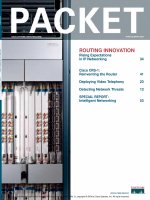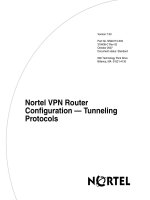IPv6 Routing Protocols pptx
Bạn đang xem bản rút gọn của tài liệu. Xem và tải ngay bản đầy đủ của tài liệu tại đây (879.14 KB, 49 trang )
© 2008 Cisco Systems, Inc. All rights reserved. Cisco ConfidentialBSCI
1
IPv6
BSCI Module 8 – Lesson 4&5
IPv6 routing
Implementing and Verifying OSPFv3
© 2008 Cisco Systems, Inc. All rights reserved.BSCI
2
CCNP – BSCI Bachkhoa Networking Academy
Học viện mạng Bách Khoa - www.bkacad.com
Objectives
Describe how OSPF for IPv6 works
Explain the similarities and differences between OSPF
for IPv6 to OSPFv2
Describe the differences between OSPF LSA types
used with IPv4 and IPv6
Explain the configuration modes and Cisco IOS
attributes specific to OSPFv3
Explain how to configure OSPFv3
Explain how to verify OSPFv3
© 2008 Cisco Systems, Inc. All rights reserved.BSCI
3
CCNP – BSCI Bachkhoa Networking Academy
Học viện mạng Bách Khoa - www.bkacad.com
IPv6 Routing
Protocols
© 2008 Cisco Systems, Inc. All rights reserved.BSCI
4
CCNP – BSCI Bachkhoa Networking Academy
Học viện mạng Bách Khoa - www.bkacad.com
IPv6 Routing Protocols
IPv6 routing types:
–Static
–RIPng (RFC 2080)
–OSPFv3 (RFC 2740)
–IS-IS for IPv6
–MP-BGP4 (RFC 2545/2858)
–EIGRP for IPv6
ipv6 unicast-routing command is required to
enable IPv6 before any routing protocol configured.
© 2008 Cisco Systems, Inc. All rights reserved.BSCI
5
CCNP – BSCI Bachkhoa Networking Academy
Static route
Configuring Static IPv6 Routes
Router(config)#ipv6 route ipv6-prefix/prefix-length
{next-hop | interface} [distance]
Displaying IPv6 Routes
Router#show ipv6 route
© 2008 Cisco Systems, Inc. All rights reserved.BSCI
6
CCNP – BSCI Bachkhoa Networking Academy
Học viện mạng Bách Khoa - www.bkacad.com
RIPng
Same as IPv4:
–Distance-vector, radius of 15 hops, split-horizon, and poison
reverse
–Based on RIPv2
Updated features for IPv6:
–IPv6 prefix, next-hop IPv6 address
–Uses the multicast group FF02::9, the all-rip-routers multicast
group, as the destination address for RIP updates
–Uses IPv6 for transport
–Named RIPng
© 2008 Cisco Systems, Inc. All rights reserved.BSCI
7
CCNP – BSCI Bachkhoa Networking Academy
Configuring RIPng
Router(config)#ipv6 router rip tag
© 2008 Cisco Systems, Inc. All rights reserved.BSCI
8
CCNP – BSCI Bachkhoa Networking Academy
Học viện mạng Bách Khoa - www.bkacad.com
Integrated Intermediate System-to-
Intermediate System (IS-IS)
Same as for IPv4.
Extensions for IPv6:
–2 new type-length-values (TLV):
•IPv6 reachability (with 128 bits prefix)
•IPv6 interface address (with 128 bits)
–New protocol identifier
–Not yet an IETF standard
© 2008 Cisco Systems, Inc. All rights reserved.BSCI
9
CCNP – BSCI Bachkhoa Networking Academy
Học viện mạng Bách Khoa - www.bkacad.com
Multiprotocol Border Gateway Protocol
(MP-BGP) (RFC 2858)
Multiprotocol extensions for BGPv4:
–Enables protocols other than IPv4.
–New identifier for the address family.
IPv6 specific extensions:
–Scoped addresses: NEXT_HOP contains a global IPv6
address and potentially a link-local address (only when there is
a link-local reachability with the peer).
–NEXT_HOP and NLRI (Network Layer Reachability
Information) are expressed as IPv6 addresses and prefix in the
multiprotocol attritubes.
© 2008 Cisco Systems, Inc. All rights reserved.BSCI
10
CCNP – BSCI Bachkhoa Networking Academy
IS-IS for IPv6
Large address support facilitates the IPv6 address
family. Intermediate System to Intermediate System
(IS-IS) is the same as IPv4 with the following
extensions added:
Two new Type, Length, Value (TLV) attributes
IPv6 reachability
IPv6 interface address
New protocol IDS
Not yet an IETF standard
Học viện mạng Bách Khoa - www.bkacad.com
© 2008 Cisco Systems, Inc. All rights reserved.BSCI
11
CCNP – BSCI Bachkhoa Networking Academy
Học viện mạng Bách Khoa - www.bkacad.com
OSPF Version 3 (OSPFv3) (RFC 2740)
Similar to OSPV for IPv4:
–Same mechanisms, but a major rewrite of the internals of the
protocol
Updated features for IPv6:
–Every IPv4-specific semantic is removed
–Carry IPv6 addresses
–Link-local addresses used as source
–IPv6 transport
–OSPF for IPv6 is currently an IETF proposed standard
© 2008 Cisco Systems, Inc. All rights reserved.BSCI
12
CCNP – BSCI Bachkhoa Networking Academy
Implement OSPF for IPv6
Enabling OSPF for IPv6 on an Interface
–1. enable
–2. configure terminal
–3. interface type number
–4. ipv6 ospf process-id area area-id [instance instance-id]
Defining an OSPF for IPv6 Area Range
–1. enable
–2. configure terminal
–3. ipv6 router ospf process-id
–4. area area-id range ipv6-prefix/prefix-length [advertise |
not-advertise] [cost cost]
© 2008 Cisco Systems, Inc. All rights reserved.BSCI
13
CCNP – BSCI Bachkhoa Networking Academy
Defining Authentication on an Interface
–1. enable
–2. configure terminal
–3. interface type number
–4. ipv6 ospf authentication ipsec spi spi md5 [key-
encryption-type {key | null}]
© 2008 Cisco Systems, Inc. All rights reserved.BSCI
14
CCNP – BSCI Bachkhoa Networking Academy
Học viện mạng Bách Khoa - www.bkacad.com
Self Check
1. What global configuration command is used to enable
IPv6 before any routing protocol can be configured?
2. How is IPv6 similar to IPv4 classless interdomain
routing (CIDR)?
3. How does RIPng handle RIP updates?
© 2008 Cisco Systems, Inc. All rights reserved.BSCI
15
CCNP – BSCI Bachkhoa Networking Academy
Học viện mạng Bách Khoa - www.bkacad.com
OSPFv3
© 2008 Cisco Systems, Inc. All rights reserved.BSCI
16
CCNP – BSCI Bachkhoa Networking Academy
Học viện mạng Bách Khoa - www.bkacad.com
OSPFv3—Hierarchical Structure
Topology of an area is
invisible from outside of the
area:
–LSA flooding is bounded by area.
–SPF calculation is performed
separately for each area.
Backbones must be
contiguous.
All areas must have
a connection to
the backbone:
–Otherwise a virtual
link must be used to
connect to the
backbone.
© 2008 Cisco Systems, Inc. All rights reserved.BSCI
17
CCNP – BSCI Bachkhoa Networking Academy
Học viện mạng Bách Khoa - www.bkacad.com
OSPFv3—Similarities with OSPFv2
OSPFv3 is OSPF for IPv6 (RFC 2740):
–Based on OSPFv2, with enhancements
–Distributes IPv6 prefixes
–Runs directly over IPv6
OSPFv3 & v2 can be run concurrently, because each
address family has a separate SPF (ships in the night).
OSPFv3 uses the same basic packet types as OSPFv2:
–Hello
–Database description blocks (DDB)
–Link state request (LSR)
–Link state update (LSU)
–Link state acknowledgement (ACK)
© 2008 Cisco Systems, Inc. All rights reserved.BSCI
18
CCNP – BSCI Bachkhoa Networking Academy
Học viện mạng Bách Khoa - www.bkacad.com
OSPFv3—Similarities with OSPFv2
Neighbor discovery and adjacency formation
mechanism are identical.
RFC compliant NBMA and point-to-multipoint topology
modes are supported. Also supports other modes from
Cisco such as point-to-point and broadcast, including
the interface.
LSA flooding and aging mechanisms are identical.
© 2008 Cisco Systems, Inc. All rights reserved.BSCI
19
CCNP – BSCI Bachkhoa Networking Academy
Học viện mạng Bách Khoa - www.bkacad.com
Enhanced Routing Protocol Support
Differences from OSPFv2
OSPFv3 has the same five packet types, but some
fields have been changed.
All OSPFv3 packets have a 16-byte header verses the
24-byte header in OSPFv2.
© 2008 Cisco Systems, Inc. All rights reserved.BSCI
20
CCNP – BSCI Bachkhoa Networking Academy
Học viện mạng Bách Khoa - www.bkacad.com
OSPFv3—Differences from OSPFv2
OSPFv3 protocol processing per-link, not per-subnet:
IPv6 connects interfaces to links.
Multiple IPv6 subnets can be assigned to a single link.
Two nodes can talk directly over a single link, even
though they do not share a common subnet.
The terms “network” and “subnet” are being replaced
with “link”.
An OSPF interface now connects to a link instead of a
subnet.
© 2008 Cisco Systems, Inc. All rights reserved.BSCI
21
CCNP – BSCI Bachkhoa Networking Academy
Học viện mạng Bách Khoa - www.bkacad.com
OSPFv3—Differences from OSPFv2
Multiple OSPFv3 protocol instances can now run over a
single link:
This allows for separate autonomous systems, each
running OSPF, to use a common link. A single link
could belong to multiple areas.
Instance ID is a new field that is used to have multiple
OSPFv3 protocol instances per link.
In order to have two instances talk to each other, they
need to have the same instance ID. By default it is 0,
and for any additional instance it is increased.
© 2008 Cisco Systems, Inc. All rights reserved.BSCI
22
CCNP – BSCI Bachkhoa Networking Academy
Học viện mạng Bách Khoa - www.bkacad.com
OSPFv3—Differences from OSPFv2
Multicast addresses:
–FF02::5 – Represents all SPF routers on the link local scope;
equivalent to 224.0.0.5 in OSPFv2.
–FF02::6 – Represents all DR routers on the link local scope;
equivalent to 224.0.0.6 in OSPFv2.
Removal of address semantics:
–IPv6 addresses are no longer present in OSPF packet header (part of
payload information).
–Router LSA and network LSA do not carry IPv6 addresses.
–Router ID, area ID, and link-state ID remains at 32 bits.
–DR and BDR are now identified by their router ID and no longer by
their IP address.
Security:
–OSPFv3 uses IPv6 AH and ESP extension headers instead of variety
of mechanisms defined in OSPFv2.
© 2008 Cisco Systems, Inc. All rights reserved.BSCI
23
CCNP – BSCI Bachkhoa Networking Academy
Học viện mạng Bách Khoa - www.bkacad.com
LSA Overview
LSA Function
Code
LSA Type
Router-LSA 1 Ox2001
Network-LSA 2 Ox2002
Inter-Area-Prefix-LXA 3 Ox2003
Inter-Area-Router-LSA 4 Ox2004
AS-External-LSA 5 Ox4005
Group-Membership-LSA 6 Ox2006
Type-7-LSA 7 Ox2007
Link-LSA 8 Ox2008
Intra-Area-Prefix-LSA 9 Ox2009
New
Renamed
© 2008 Cisco Systems, Inc. All rights reserved.BSCI
24
CCNP – BSCI Bachkhoa Networking Academy
Học viện mạng Bách Khoa - www.bkacad.com
Larger Address Space Enables
Address Aggregation
Aggregation of prefixes announced in the global routing
table
Efficient and scalable routing
Improved bandwidth and functionality for user traffic
© 2008 Cisco Systems, Inc. All rights reserved.BSCI
25
CCNP – BSCI Bachkhoa Networking Academy
Học viện mạng Bách Khoa - www.bkacad.com
Self Check
1. Can OSPFv3 and v2 run concurrently?
2. List some similarities between OSPFv3 and OSPFv2.
3. Explain the difference between OSPFv3 and OSPFv2
in terms of links or subnets.
4. What is Instance ID?









